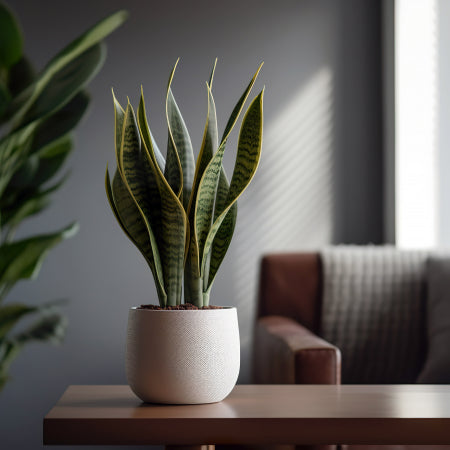Tips to Grow and Take Care of Money Plants
Welcome to our simple money plant care guide! In this blog, we’ll share all the easy tips to grow money plant at your home.
Money plants, also known as Epipremnum aureum, Pothos, or Devil’s Ivy, are native to the Solomon Islands in the South Pacific. They are popular houseplants due to their low-maintenance nature and attractive foliage. The leaves are heart-shaped and can vary in color, from green to variegated patterns with yellow or white patches.
Tips to Grow Money Plant
Caring for money plants is relatively simple, making them perfect for novice gardeners or those with busy schedules. They can tolerate a range of conditions, but to keep them looking their best, follow these guidelines:
Aspect |
Tip |
| Watering | – Water when the top inch of soil is dry. |
| – Avoid overwatering to prevent root rot. | |
| Soil | – Use well-draining, peat-based potting mix. |
| – Fertilize every 4-6 weeks in spring and summer. | |
| Light | – Provide bright, indirect light. |
| – Avoid direct sunlight to prevent leaf burn. | |
| Propagation | – Use stem cuttings or air layering. |
| – Ensure new roots are 1-2 inches before potting. | |
| Pruning | – Trim regularly to maintain shape. |
| – Prune above leaf nodes to encourage growth. | |
| Pest Control | – Inspect regularly for pests and treat promptly if needed. |
Watering
Money plants are somewhat drought-tolerant but prefer consistent moisture. Water your plant when the top inch of soil is dry to the touch, usually once every 7-10 days, depending on the humidity and temperature of your home. The best time to water is in the morning, allowing the plant to uptake water before the day’s heat causes evaporation. Be careful not to overwater, as this can lead to root rot. If you notice yellowing leaves, it may be a sign of overwatering.
Soil Requirements
Money plants grow best in a well-draining, peat-based potting mix. This type of soil retains moisture without becoming waterlogged, allowing the plant’s roots to access the water they need without risking root rot. Fertilize your money plant every 4-6 weeks during the growing season (spring and summer) using a balanced, water-soluble fertilizer. Follow the package instructions for the correct dilution rate. During the fall and winter, reduce fertilization to once every 8-12 weeks as the plant’s growth slows down.
Light Requirements
Money plants thrive in bright, indirect light. A spot near a north- or east-facing window is ideal, but they can also tolerate lower light conditions. Keep in mind that variegated varieties may lose some of their color if they do not receive enough light. Avoid placing your money plant in direct sunlight, as this can cause the leaves to burn and become discolored. If you notice that the leaves are becoming leggy or losing their variegation, try moving the plant to a brighter location. If your home does not have sufficient natural light, you can supplement with artificial lighting, such as fluorescent or LED grow lights. Ensure the light source is placed above the plant, mimicking the natural direction of sunlight, and provide 12-14 hours of light per day.
Propagation Techniques
One of the joys of growing money plants is their ease of propagation. You can quickly multiply your collection or share with friends using these methods:
Stem Cuttings
- Choose a healthy stem with at least four leaves and make a clean cut just below a node (where the leaf meets the stem).
- Remove the lower leaves, leaving at least two on the cutting.
- Place the cutting in a glass of water, ensuring the node is submerged but the leaves remain above the waterline.
- Change the water every few days to prevent bacteria growth.
- After 2-3 weeks, new roots should form from the node.
- Once the roots are 1-2 inches long, transfer the cutting to a pot filled with well-draining potting mix.
Air Layering
- Select a healthy stem with at least four leaves.
- Make a small, upward-slanting cut halfway through the stem, just below a node.
- Insert a toothpick into the cut to keep it open.
- Wrap the area with moist sphagnum moss, then cover the moss with plastic wrap, securing it with twine or rubber bands.
- After 2-4 weeks, roots should begin to form in the moss.
- Cut the stem below the new root system, carefully remove the plastic wrap and moss, and plant the newly rooted stem in a pot filled with well-draining potting mix.
Pruning and Training
Regular pruning and training will keep your money plant looking its best and encourage bushier growth. Prune your plant by cutting just above a leaf node, which will stimulate new growth from that point. You can prune any time of year, but it’s best to do so during the growing season to ensure faster recovery.
Training your money plant can be done using a moss pole, trellis, or other support structures. Attach the plant’s stems to the support using plant ties, allowing the plant to climb and create a more vertical growth habit. This will also help prevent the plant from becoming too heavy and breaking under its own weight.
Common Issues and Solutions
Despite their hardiness, money plants can encounter a few common issues:
- Yellowing Leaves: Often a sign of overwatering. Allow the soil to dry out before watering again.
- Leggy Growth: Indicates insufficient light. Move the plant to a brighter location.
- Pest Infestations: Regularly inspect for pests such as spider mites or aphids and treat promptly with appropriate pest control methods.
By following these care guidelines, you’ll be well-equipped to help your money plant flourish. With proper care, these resilient houseplants will add beauty and greenery to your home for years to come. Check out the 12 types of Money plants. Happy gardening!







